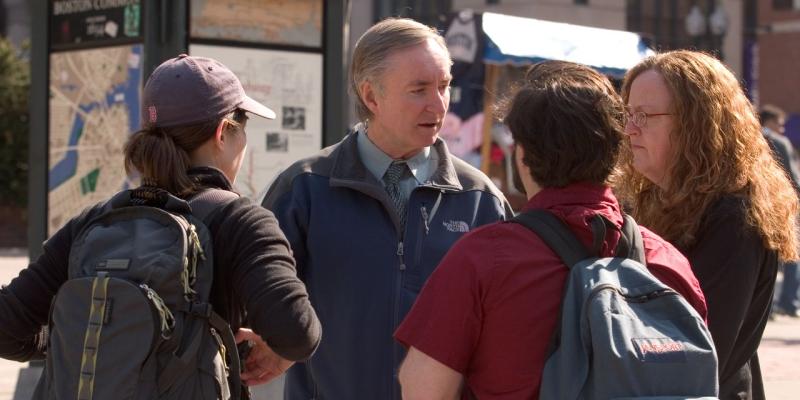'Rough Sleepers' Review: On the Streets of Boston
By: WSJ



In a memorable scene from Tracy Kidder's excellent and immersive profile of Jim O'Connell, the president of Boston's Health Care for the Homeless program, Dr. O'Connell wakes up alone, a patient in the intensive-care unit of Massachusetts General Hospital. The ICU is enforcing a strict no-visitors edict. Even his wife cannot see him.
On this morning after a pacemaker operation, Dr. O'Connell hears a familiar voice: "How ya feelin'?" It's Billy Bianchino, who camps out on the Boston streets and is a longtime beneficiary of Dr. O'Connell's program. Sneaking into the ICU was no challenge for Mr. Bianchino, one of Dr. O'Connell's "old classics"—a group that assembles most days on a tiny concrete plaza outside MGH. Dr. O'Connell has devoted his career to such people and preaches the importance of visiting patients when they are "languishing in the hospital, lonesome and afraid." Now a homeless visitor has slipped through MGH security to comfort him. Dr. O'Connell had cast his bread upon the waters, and it's floated back to nourish him.
Readers familiar with Mr. Kidder’s work will make the connection between his latest, “Rough Sleepers,” and one of his earlier books, “Mountains Beyond Mountains” (2003), a profile of another Harvard-sprung medical missionary, Dr. Paul Farmer, who died last year. Farmer painted on a large canvas. His creation, Partners in Health, has projects providing healthcare in developing countries all over the world. By comparison, Dr. O’Connell is a miniaturist. His patient base of 300 to 400 rough sleepers—a 19th-century Britishism for those who generally spend the night outdoors—is a “bathtub” compared to the ocean of outdoor homelessness in, say, greater Los Angeles.
When Dr. O’Connell took the job at Health Care for the Homeless in 1985, he planned to stay only a year. New York’s Memorial Sloan Kettering Cancer Center had offered him a prestigious oncology fellowship and, at age 37—he had studied philosophy and taught high school before turning to medicine—it was time to jump-start his career. In his first year on the job in Boston, AIDS and a tuberculosis outbreak killed 56 rough sleepers. “No matter what they did, everyone died,” Mr. Kidder writes. “The situation was appalling, the work overwhelming. And, if he was honest with himself, utterly fascinating.” Dr. O’Connell never went to New York. Sloan-Kettering’s loss redounded to the benefit of such colorful characters as Mr. Bianchino and the pseudonymous “Tony,” an ex-con who claims, delusionally, to be Dr. O’Connell’s nephew.
In 30-plus years, Dr. O’Connell’s mission has changed in unexpected ways. As a young doctor ministering from a van at night, he carried a pint bottle of whiskey that he would offer his patients to assuage the symptoms of their alcohol withdrawal. “You couldn’t do that now,” he says. “It’s become a moral issue.” He also used to hand out cash on his street rounds, knowing that a few dollars might finance some needed nutrition for one of his charges. The 21st century deep-sixed that habit, too. An employee complained that Dr. O’Connell’s gifts created a “hostile work environment” as patients favored him over other providers in the clinic. Most want to see Dr. O’Connell anyway. “I want to change my doctor,” one nighttime denizen tells him. “I hear good things about you.”
Choosing their doctor is one of many ironies attending what Dr. O’Connell calls “upside-down medicine” for the homeless, who receive house calls, if you will, from some of the city’s best-trained doctors. And for patients who refuse medical examinations, the phrase “vital signs” has a radically different meaning: Dr. O’Connell was once taught to put away his stethoscope and start washing his patients’ feet when they came to see him. “Feet were often diagnostic in themselves,” Mr. Kidder writes.
Dr. O’Connell flouts many traditional practice boundaries, including fielding patient calls at home at night. “Why does Jim allow this?” one frustrated colleague asks. Good question. He’s certainly not “curing” homelessness. Dr. O’Connell once believed that housing the homeless solved the problem. After finding half a dozen corpses of the formerly homeless in newly occupied apartments, Jill—his assistant at the time and later his wife—coined the phrase “death by housing.” As Mr. Kidder writes: “Finding their corpses left Jim and Jill wondering if they weren’t violating the physician’s oath, actually harming patients by putting them in apartments.” Dr. O’Connell now believes housing to be “more complicated than medicine.”
He is also skeptical of grand solutions, such as ambitious plans to mitigate homelessness in cities, including Denver and San Francisco—plans that end up making the problem worse. One modest proposal: “Pay public school teachers $200,000 a year and maybe thirty years later homelessness [will] become a rarity.” According to Dr. O’Connell, the most accurate indicator of someone’s health is educational status. A stronger school system, he believes, would stanch “the faucet” of homelessness.
Dr. O’Connell is often reminded that he is a doctor, not a social engineer. His late friend Barbara McInnis, who was a lay member of the Dominican religious order, proved happy to interrupt his big-picture reveries. “Who are you? God?” she once asked. “Your job is to take care of that broken foot.” Invited to ruminate on the “problem of homelessness,” McInnis would answer: “Stop torturing me with what society isn’t about to do. Let’s just do the best we can right now and take care of these folks.”
The suffering abides and the work is its own reward. Which is not to say that Dr. O’Connell’s mission hasn’t improved life for the homeless. In the early years of the program, Mr. Kidder writes, “there were bodies on the pavement [with] illnesses that American doctors knew only from textbooks—including wounds full of maggots and even a case of scurvy.” Now, Dr. O’Connell says, “it’s mostly diabetes and hypertension. I think it’s something to celebrate.”
Dr. O’Connell feels “the satisfaction all craftsmen feel in practicing their trades well,” Mr. Kidder concludes. The sure-handed narrator Mr. Kidder must feel this satisfaction, too.
Mr. Beam’s latest book is “Broken Glass: Mies van der Rohe, Edith Farnsworth, and the Fight Over a Modernist Masterpiece.”





Tracy Kidder is a unique writer with empathy for the homeless and those who volunteer. I believe he has a Pulitzer Prize for "Soul of a New Machine." I don't share the view that the homeless or the mentally ill have rights.
At any rate, the book is:
Rough Sleepers: Dr. Jim O'Connell's Urgent Mission to Bring Healing to Homeless People
[deleted]